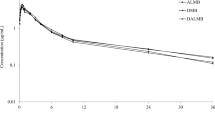Summary
Changes in the distribution of sulphamethoxazole and trimethoprim in whole blood, plasma and erythrocytes at steady-state in patients treated with cotrimoxazole have been studied. Unlike sulphamethoxazole, trimethoprim was weakly bound to erythrocytes and was partially liberated when the erythrocytes were rinsed with isotonic saline. The maximal steady-state concentration of trimethoprim in whole blood was 3 mg/l, but calculated on the basis of the concentration determined in erythrocytes it was 1.8 mg/l. Erythrocytes may be of great significance in trimethoprim distribution as carriers of a readily liberated reservoir of the drug. Acetylated sulphamethoxazole derivatives occurred in a higher percentage in erythrocytes at the maximal steady-state concentration (9.9%) than at the level (7.3%), which may help in interpreting the behaviour of this metabolite in other cells in the organism.
Similar content being viewed by others
References
Böhni E (1969) Vergleichende bakteriologische Untersuchungen mit der Kombination Trimethoprim/Sulphamethoxazole in vitro und in vivo. Chemotherapy 14 [Suppl]: 1–21
Nowak A, Kadyków M, Klimowicz A (1983) Penetration of trimethoprim and sulphamethoxazole into skin blister fluid. Eur J Clin Pharmacol 25: 825–827
Nowak A, Kadyków M, Klimowicz A (1983) Skin contribution to the distribution of co-trimoxazole constituents. Pol Tyg Lek 38: 393–396 (in Polish)
Nowak A, Kadyków M, Klimowicz A (1983) The role of the skin in sulphamethoxazole distribution. Pol Tyg Lek 38: 521–524 (in Polish)
Nowak A, Kadyków M, Klimowicz A (1983) Skin contribution to trimethoprim distribution. Pol Tyg Lek 38: 1077–1078 (in Polish)
Rieder J (1972) Quantitative determination of the bacteriostatically active fraction of sulphonamides and the sum of their inactive metabolites in the body fluids. Chemotherapy 17: 1–21
Rieder J (1976) The simultaneous quantitative determination of ‘total’, ‘active’, ‘acetylated’ and ‘conjugated’ sulfonamide in biological fluids. Chemotherapy 22: 84–87
Bratton AC, Marshall EK Jr, Babbit D, Hendrickson AR (1939) A new coupling component for sulphonamide determination. J Biol Chem 128: 537–550
Klimowicz A (1981) Spectrophotometric determination of trimethoprim in human plasma and blood. Diagn Lab 17: 35–40 (in Polish)
Ludwig E, Csiba A, Magyar T, Szöcs G, Graber H (1983) Age-associated pharmacokinetic changes of metronidazole. Int J Clin Pharmacol 21: 87–91
Richterich R (1971) Clinical chemistry. PZWL, Warszawa, pp 32–35 (in Polish)
Korn A, Hitzenberger H, Jaschek J, Pichler H (1972) Pharmacokinetic of the combination of trimethoprim with sulphamethoxazole. In: Hejzlar M, Semonsky M, Masak S (eds) Advances in antimicrobial and antineoplastic chemotherapy. Avicenum, Czechoslovak Medicinal Press, Prague
Kremers P, Duvivier J, Heugshem C (1974) Pharmacokinetic studies of co-trimoxazole in man after single and repeated doses. J Clin Pharmacol 14: 112–117
Nolte H, Büttner H (1974) Investigation on plasma levels of sulphamethoxazole in man after single and chronic oral administration alone and in combination with trimethoprim. Chemotherapy 20: 321–330
Nolte H, Büttner H (1973) Pharmacokinetics of trimethoprim and its combination with sulphamethoxazole in man after single and chronic oral administration. Chemotherapy 18: 274–284
Neugodova NP, Gejtman IJ, Kiwman GJ (1979) Basic concepts of binding studies of sulfonamides. Khim Pharm J 6: 13–18 (in Russian)
Berneis K, Boguth W (1976) Distribution of sulfonamides and sulfonamide potentiators between red blood cells, proteins and aqueous phases of the blood of different species. Chemotherapy 22: 390–409
Schwartz DE, Ziegler WH (1969) Assay and pharmacokinetics of trimethoprim in man and animals. Postgrad Med J 45 [Suppl]: 32–37
Craig WA, Kunin CM (1973) Trimethoprim-sulphamethoxazole pharmacodynamic effects of urinary pH and impaired renal function. Ann Intern Med 78: 491–497
Kaplan SA, Weinfeld RE, Cotler S, Abruzzo CW, Alexander K (1970) Pharmacokinetic profile of trimethoprim in dog and man. J Pharm Sci 59: 358–363
Lichtenwalner DM, Suh B, Lorber B, Sugar AM (1979) Rapid assay for determination of trimethoprim and sulphamethoxazole levels in serum by spectrofluorometry. Antimicrob Agents Chemother 16: 579–583
Wilkinson PJ, Reeves DS (1979) Tissue penetration of trimethoprim and sulphonamides. J Antimicrob Chemother 5 [Suppl B]: 159–168
Vree TB, Hekster YA, Damsma JE, van der Kleijn E, O'Reilly WJ (1979) Pharmacokinetics of N1-acetyl-and N4-acetylsulphamethoxazole in man. Clin Pharmacokinet 4: 310–319
Witzgall H, Boyens H (1964) Die Bedeutung der Bindung an Albumin, Körperzellen und Bakterien für Pharmakodynamik und Wirkung von Arzneistoffen. Arch Int Pharmacodyn 148: 511–535
Author information
Authors and Affiliations
Rights and permissions
About this article
Cite this article
Nowak, A., Klimowicz, A. & Kadyków, M. Distribution of trimethoprim and sulphamethoxazole in blood during treatment with co-trimoxazole. Eur J Clin Pharmacol 29, 231–234 (1985). https://doi.org/10.1007/BF00547428
Received:
Accepted:
Issue Date:
DOI: https://doi.org/10.1007/BF00547428




